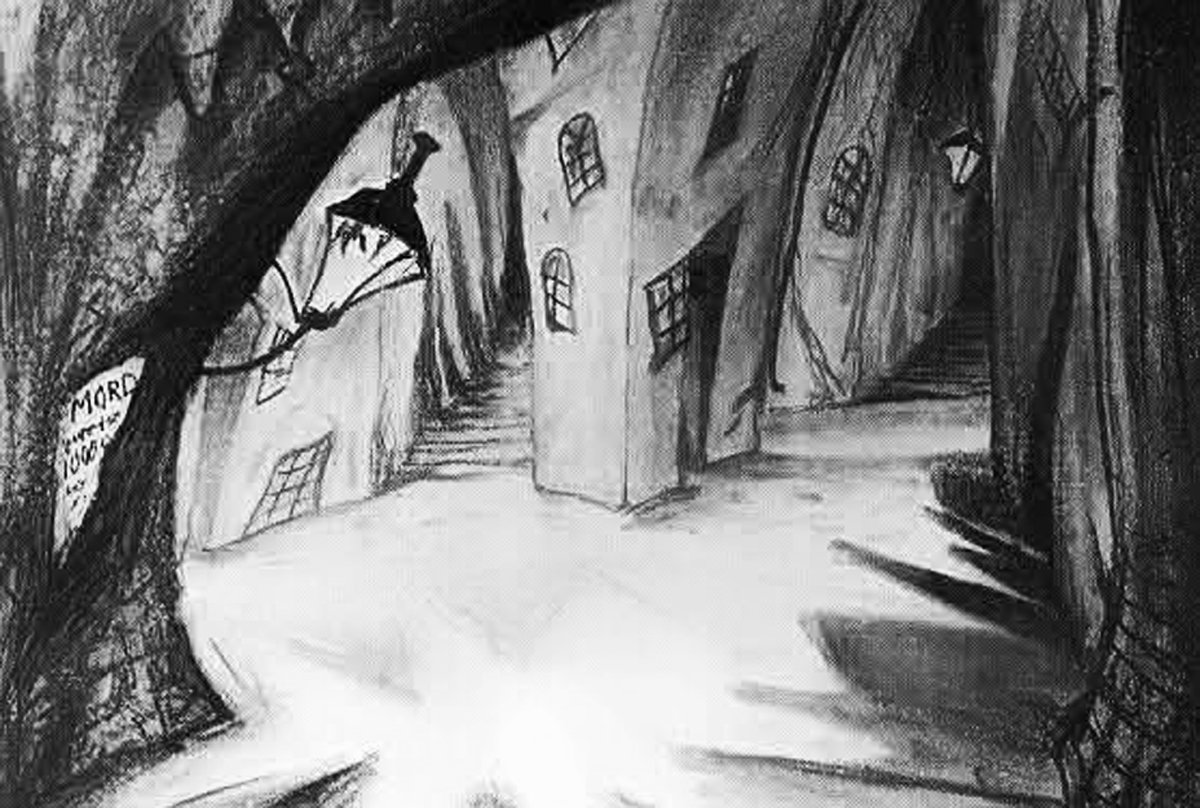Robert Wiene's Das Cabinet des Dr. Caligari (1920) is an interesting and dark tale set in the town of Holstenwall, which is brought to life on an elaborate and bizarre looking set, the appearance of which brings to mind the imaginative drawings of Dr Seuss, with its zigzagging streets and block-like buildings that go up in every direction, all similar in style, but no two exactly the same.
 |
| Fig 1: Concept art for Holstenwall |
Das Cabinet des Dr. Caligari has been called "a mute opera of fear" (Bradshaw, 2014) and "arresting and provocative" (French, 2014). The unrealistic set, over the top acting and symbolism are what make the film so intriguing. It can be argued that, had the film been made at a later date, with new technology, it would not have received the same amount of praise as it has. If the film had been made in colour instead of black and white, it would not have the same atmosphere as it does. In black and white, the sets are full of dark corners, giving a sense of danger and fear of what may be lurking in the shadows. Even the silence adds to the film, as the audience can only witness the violence of Alan's death, not hear it. The acting may be bold, and sometimes seem a little silly, but the actors do a fantastic job of showing their feelings through expression and movement rather than words. The heavy use of makeup gives their eyes more expression, and looks of astonishment, wonder and fear are far more clear.
| Fig 2: The jagged streets and buildings of Holstenwall. |
Das Cabinet des Dr. Caligari is believed to have "lay down a template for today's scary movies, noirs and psychological thrillers." (Bradshaw, 2014). Watching the film, the audience may notice scenes and tropes they are used to from more modern films. Things such as the silhouette of the murderer at the window, or the shadow of a threatening figure looming over its victim, are all used in modern films and TV shows to create a threatening atmosphere, and can be seen in Das Cabinet des Dr. Caligari. It is very clear how this film inspired future filmmakers.
A common trope that appears in this film is the image of a large, dark and (on occasion) dangerous character carrying a "damsel in distress". This is seen in more modern films such as King Kong (1933) and is often used in superhero comics.
| Fig 3: Cesare flees with Jane. |
Images:
Fig 1. Concept art for Holstenwall [Concept art] At: https://one1more2time3.wordpress.com/tag/live-action/ (Accessed on 22.09.15)
Fig 2. The jagged streets and buildings of Holstenwall (1920) From: Das Cabinet des Dr. Caligari. Directed by: Robert Wiene. [Film still] Germany: Decla-Bioscop AG. At: http://wallpapers2015.mobi/the-cabinet-of-dr-caligari-wallpapers/ (Accessed on 22.09.15)
Fig 3. Cesare flees with Jane (1920) From: Das Cabinet des Dr. Caligari. Directed by: Robert Wiene. [Film still] Germany: Decla-Bioscop AG. At: http://wallpapers2015.mobi/the-cabinet-of-dr-caligari-wallpapers/ (Accessed on 22.09.15)
Bibliography:
Bradshaw, Peter. (2014) "The Cabinet of Dr Caligari review - occult scary-movie touchstone from 1920" In: theguardian.com 28.08.14 [online] At: http://www.theguardian.com/film/2014/aug/28/the-cabinet-of-dr-caligari-film-review (Accessed on 22.09.15)
French, Philip. (2014) "The Cabinet of Dr Caligari review - Philip French on one of cinema's first masterpieces" In: theguardian.com 05.10.14 [online] At: http://www.theguardian.com/film/2014/oct/05/cabinet-of-dr-caligari-dvd-review-classic-french (Accessed on 22.09.15)

A thoughtful and well-referenced first review Eleanor, well done :)
ReplyDeleteJust a couple of points; don't forget to italicise your quotes as this helps distinguish them from the rest of your text. It is also quite useful to refer directly to the images that you have used, as a way of helping your reader visualise what you are describing; so for example, when you talk about the jagged set, you could add something like '...as shown in fig. 2.' (you don't need to do this for every mage, but certainly ones that directly illustrate a point you are making.)
You seem to have confused the names of the two lead characters :) Alan was the one that was murdered, and Francis was the one in the asylum... easily done, don't worry! :D
Looking forward to your next review!
Oh dear! I'll quickly edit the names. Thank you :)
Delete